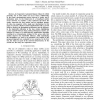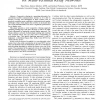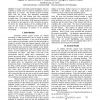385 search results - page 9 / 77 » Throughput Achievable with No Relaying in a Mobile Interfere... |
GLOBECOM
2010
IEEE
13 years 5 months ago
2010
IEEE
This paper considers a relay-assisted bidirectional cellular network where the base station (BS) communicates with each mobile station (MS) using orthogonal frequency-division mult...
ICC
2009
IEEE
13 years 5 months ago
2009
IEEE
In Cooperative Automatic Repeat reQuest (C-ARQ) protocols, one or more nodes can act as relays, collaborating in the frame retransmission process between a sender and a destination...
MOBIHOC
2010
ACM
13 years 5 months ago
2010
ACM
We investigate the performance of longest-queue-first (LQF) scheduling (i.e., greedy maximal scheduling) for wireless networks under the SINR interference model. This interference...
ICC
2007
IEEE
14 years 1 months ago
2007
IEEE
— Cooperative relaying is a promising alternative for conventional mobile communications systems as it is able to increase coverage and throughput of these systems. Due to practi...
GLOBECOM
2006
IEEE
14 years 1 months ago
2006
IEEE
: To improve downlink packet throughput, the base schedules a mobile when its signal to interference ratio is higher than on average. The mobiles measure downlink pilots from the s...



